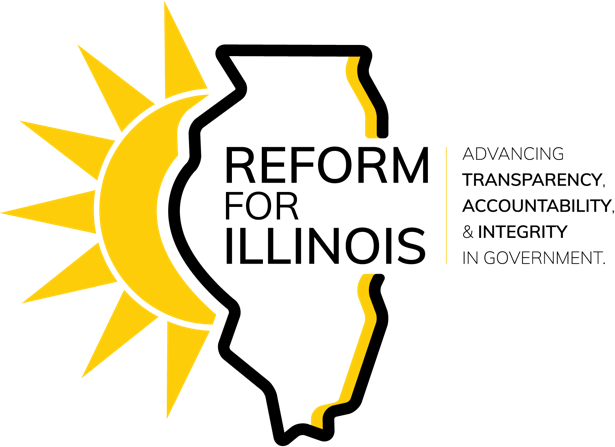The Value of a Small Dollar: An Analysis of Small Donations in the 2020 Illinois General Assembly Elections
With the final quarterly campaign finance reports of 2020 submitted in mid-January, we now have a complete picture of the role that small donations played in the November elections for the Illinois General Assembly. And that role is, well, small.
In Illinois, campaigns for state and local offices do not need to report the name and other information of donors who contribute $150 or less over the course of an election cycle. Instead, those “small” donations are reported as a single lump sum of non-itemized distributions.
Although political campaigning is a billion-dollar industry, the vast majority of people do not make any contributions at all. We can’t put an exact number of people who make small donations at the state or federal level because they’re usually not itemized, but polling suggests that only about 10% of Americans make political donations. Campaign committee disclosures show that just 1.38% of Americans gave $200 or more to candidates for federal office during the 2020 election cycle.
Despite their small size, small donations are an important part of the political process. Candidates, particularly at the federal level, often attempt to highlight the number of small donations they receive because they are an indication of grassroots support. During the 2020 presidential primary, the Democratic Party sought to elevate small donations by allowing candidates who had garnered enough of them to qualify for debates. And the Center for Responsive Politics found that small dollar donations accounted for 22% of the $14 billion spent on federal races in 2020 — a non-trivial, if still troublingly low, amount.
How significant were small donations in this year’s races in Illinois? Using quarterly campaign reports filed with the State Board of Elections, we analyzed the contributions that candidates for the General Assembly received between October 1, 2019, and December 31, 2020.
Our analysis primarily focuses on the House, where all 118 seats were up for election as compared to the 20 elections that took place for Senate seats. If you’re interested in a breakdown of contributions received by a particular candidate, you can find them on our spreadsheet here.
Contributions of $150 or less were a tiny proportion of all money going towards General Assembly races
A key measure of the impact of small donations is their overall size relative to large ones. One hundred sixty-nine major party candidates registered political committees to run for seats in the state House. The median percentage of non-itemized contributions to a committee was just 2.47%. Among winning House candidates, the median committee received even less — only 2.04% of its total funds — from small donations.
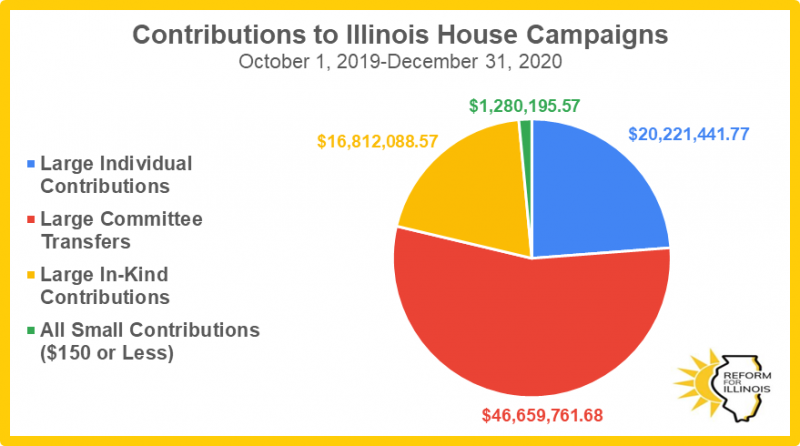
Meanwhile, candidates received more than half their total funds from transfers from other political committees, including party-controlled committees like Democratic Majority and the House Republican Organization.
The picture is similar in the Senate. Among the 32 committees formed by Senate candidates who ran in 2020, the median percentage of total contributions received from small donations was 1.9%.
This means that small donations — and small donors — play a vanishingly small role in Illinois candidates’ financial fate.
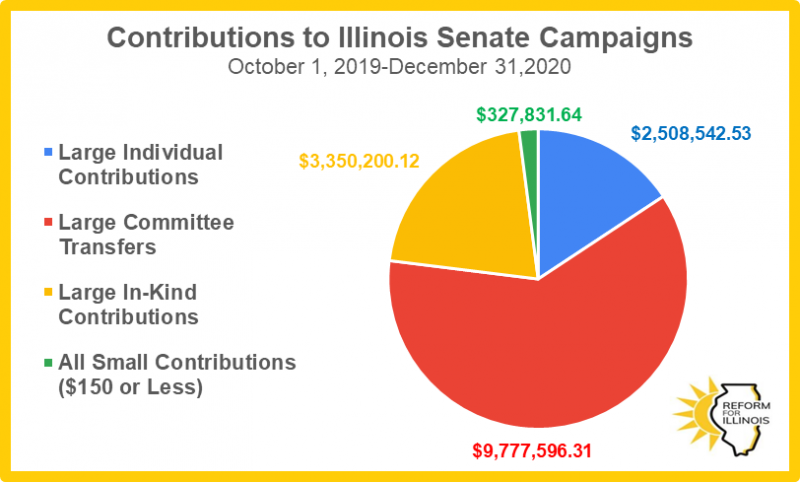
*Note that while this chart shows that House candidates reported roughly $85 million in contributions, the total number of dollars spent on House races is likely substantially less than $85 million. This is because a number of candidate committees make transfers to one another, or to party committees which then make transfers to other candidate committees, meaning that some contributions are double-counted. For example, if Majority Leader Greg Harris received a $5,800 donation from an individual and then made a $5,800 transfer to another candidate, that single contribution would show up twice when looking at contribution disclosures, first as an individual contribution on Harris’s report and then as a transfer on the report of the candidate he transferred it to. This applies to the other charts in this report as well.
Neither party is attracting many small donations
Reliance on large contributions transcends party. As the charts below show, there are some differences between the fundraising patterns of the Democratic and Republican Parties. Democratic House candidates (raising $66 million collectively) received more than half their funding as transfers from other political committees (especially the Democratic Party of Illinois and Democratic Majority), whereas Republicans (taking in just under $19 million) received a greater proportion of funds as individual contributions from entities outside the political committee ecosystem.
But the small proportion of small donations received is a shared trait of the two parties. The $690,696 that Democrats took home in non-itemized contributions amounted to just 0.9% of their total fundraising. For Republicans, they total just 3.17% of contributions—more than three times the proportion raised by Democrats, but still not a number to be proud of.
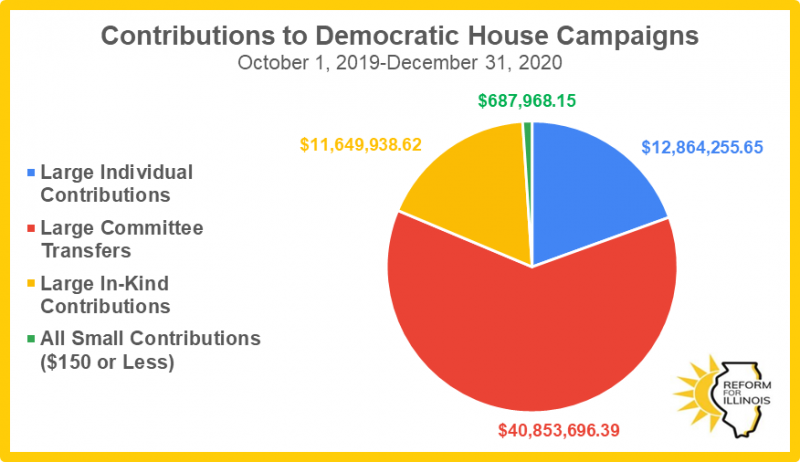
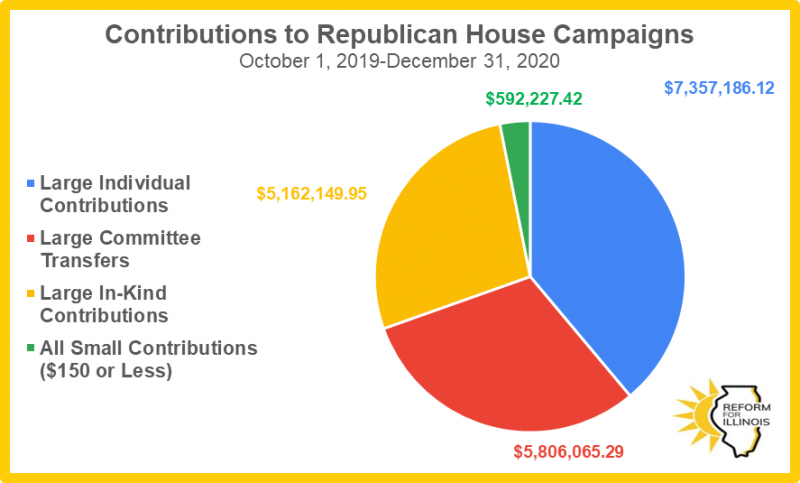
Some candidates in low-profile races raise a significant amount from small donors
While non-itemized donations make up just 1.5% of contributions overall in the House, they played a more significant role in a handful of races. Sixteen winning House candidates—twelve Republicans and four Democrats—raised more than 10% of their overall contributions from donations of $150 or less. Two factors contributed to that relatively high percentage. The first is the low overall amount of money that flowed into their races. None of the candidates ran in particularly close races, and in all cases their total contributions fell below the statewide median of $218,014 raised by a winning candidate.
The second factor was higher-than-average fundraising from small donations. The median winning House candidate reported $5,814 in non-itemized contributions. All but one candidate in the table below beat the median, some by a factor of four or five. Republican Thomas Bennett and Democrat Delia Ramirez were the biggest small donor fundraisers in their respective parties in both relative and absolute terms. That suggests that winning candidates that receive the highest proportion of small donations do so not only because their races don’t attract many large donors but also because they’re better-than-average grassroots fundraisers.
Winning House Candidates That Received More than 10% of Their Total Contributions as Non-Itemized Contributions
Candidate | Non-Itemized Contributions | Total Contributions | Percentage of Vote Received |
| Thomas Bennett (R-106) | $34,761.41 | $123,189.35 | 100% (Uncontested) |
Daniel Swanson (R-74) | $22,513.00 | $82,151.28 | 71% |
Brad Halbrook (R-102) | $16,755.00 | $62,895.27 | 72% |
Charles Meier (R-108) | $27,016.43 | $130,794.43 | 74% |
Delia Ramirez (D-4) | $29,494.32 | $143,416.39 | 100% (Uncontested) |
| Keith Sommer (R-88) | $17,455.00 | $92,341.22 | 60% |
Will Guzzardi (D-39) | $5,947.77 | $35,591.52 | 100% (Uncontested) |
Andrew Chesney (R-89) | $14,718.29 | $92,679.58 | 73% |
Randy Frese (R-94) | $12,931.29 | $88,931.29 | 76% |
Jackie Haas (R-79) | $15,911.05 | $133,119.12 | 64% |
Mike Marron (R-104) | $22,866.00 | $191,707.64 | 59% |
Kelly Cassidy (D-14) | $12,306.12 | $108,266.21 | 100% (Uncontested) |
Edgar Gonzalez Jr. (D-21) | $4,027.87 | $35,441.84 | 100% (Uncontested) |
Blaine Wilhour (R-107) | $7,685.39 | $67,822.29 | 76% |
Adam Niemerg (R-109) | $9,342.01 | $91,168.93 | 82% |
Mike Murphy (R-99) | $5,765.00 | $57,142.22 | 100% (Uncontested) |
Should we be concerned about the lack of small donors, and what can we do about it?
Citizens can participate in their democracy not just by voting, but by supporting candidates they like through volunteering for or donating to a campaign. We should have a system that rewards people for getting engaged in politics, especially with campaigns taking place in their own community or state. And we should reward candidates who want to engage with everyday constituents instead of the wealthiest people they know.
Unfortunately, in Illinois, the deck is stacked against candidates who hope to win elections based on grassroots support. The flood of millions of dollars from a relatively small group of wealthy interests threatens to overwhelm the force of a locally supported campaign. Probably not coincidentally, Illinois consistently ranks dead last in polls asking residents how much they trust their state government. When Illinoisans look at their state’s politics, many of them see a system that does not serve them and no clear avenue for improving it.
While stemming the flow of giant contributions into state and local campaigns is tricky (though certainly worth trying), the Illinois General Assembly could take action today to empower candidates who win local support and level the playing field between big and small donors, and between candidates with access to deep pockets and those without, through a public campaign financing program. These programs, also known as clean elections programs, typically use public funds to match small donations to candidates or provide “democracy dollars” to voters who can give them to their favored candidates. Doing the work of soliciting small donations, like walking the district and talking to constituents, supporting policies that respond to the needs of the majority rather than a wealthy minority, and generating enthusiasm for one’s own campaign rather than tearing down opponents becomes much more worthwhile for campaigns when small donations can yield big results. A public campaign financing program like the one that Reform for Illinois has introduced to the General Assembly would give a fighting chance to campaigns that would rather understand the needs of their constituents than chase checks from moneyed special interests and wealthy individuals.
The current dominance of big donors in elections sidelines everyday Illinoisans and undermines trust in our democracy. If Democrats or Republicans want to claim to be the party of the people and small donations, they have their work cut out for them. But they also have options. They can support reform today.
Back
